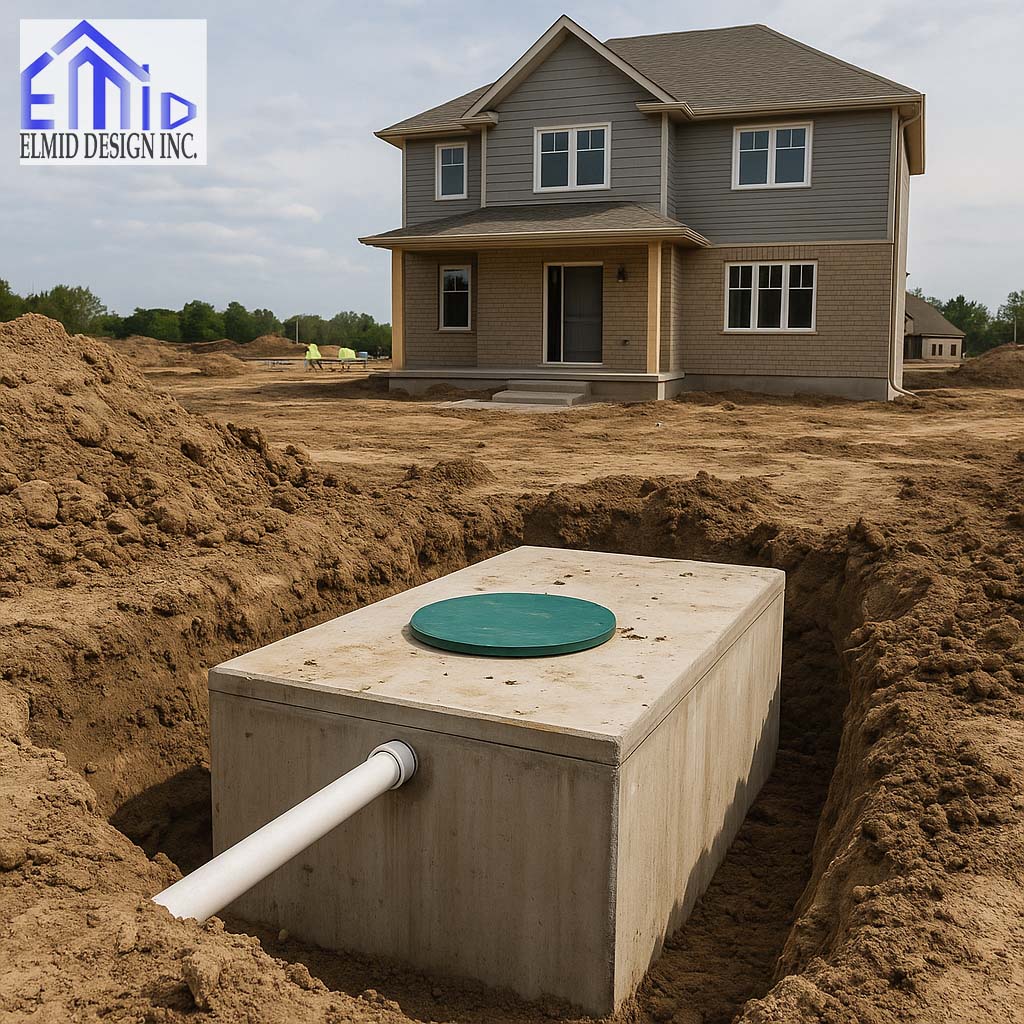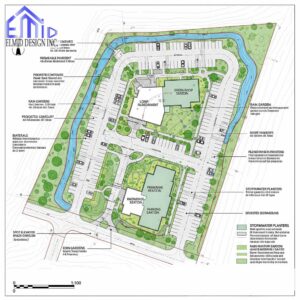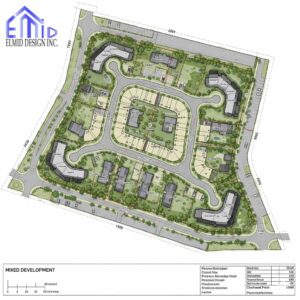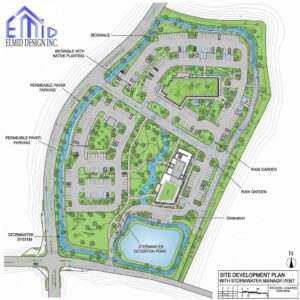Septic design Milton is an essential process for properties not connected to municipal sewers, ensuring safe and environmentally sound wastewater treatment. Milton’s diverse landscape, which includes rural areas and growing suburban developments, requires precise engineering solutions that meet local soil and groundwater conditions. Each septic system must comply with the Ontario Building Code and Halton Region’s regulations to protect both public health and the environment. A well-designed system collects, treats, and disperses wastewater efficiently while preventing contamination of wells and natural water bodies. Homeowners and developers rely on experienced engineers, such as those at Elmid Design Inc, who hold authorization from Professional Engineers Ontario, to design systems that meet high technical and legal standards. Their knowledge of local conditions and commitment to compliance ensures each project operates safely and sustainably for years to come.
Understanding Septic Design in Milton
Septic design Milton involves developing a wastewater management plan that treats household sewage on-site. The design process starts with evaluating the property’s characteristics to determine how wastewater can be safely absorbed and filtered by the soil. Milton’s combination of clay, loam, and sandy soils makes accurate testing and design essential to avoid contamination or system failure. Engineers analyze site conditions, groundwater levels, and topography to choose the best treatment approach. A professional design not only meets code requirements but also enhances property value by ensuring long-term functionality. Proper septic design supports environmental protection and reliable daily operation for residential and commercial properties throughout Milton.
Regulatory Framework for Septic Systems in Milton
Every septic design Milton must follow Ontario Building Code Part 8, which regulates small on-site sewage systems. These rules govern system size, capacity, location, and performance standards to safeguard water resources. The Halton Region Health Department oversees permit approvals for Milton, verifying that designs meet environmental and public safety standards. Local regulations also specify setback distances from wells, buildings, and property boundaries to prevent contamination. Only licensed engineers or qualified designers with Building Code Identification Numbers are permitted to design septic systems. Working with professionals ensures full compliance with municipal and provincial laws, streamlining the approval process while protecting the homeowner’s investment.
Site Evaluation and Soil Testing in Milton
Accurate soil testing is the foundation of septic design Milton. Engineers perform percolation or “T-time” tests to determine how quickly soil absorbs water, which influences the system’s size and configuration. Milton’s varying soil composition requires detailed testing to assess permeability and water table depth. Clay-heavy soils drain slowly and may require raised systems, while sandy soils need special filtration measures to avoid groundwater contamination. Site evaluation also includes topographical analysis, vegetation review, and groundwater monitoring to identify any environmental risks. These evaluations ensure the system design matches local soil conditions, guaranteeing efficient wastewater treatment and long-term reliability.
Sizing the Septic System in Milton
System sizing is a critical part of septic design Milton because it determines how effectively wastewater will be managed. Engineers calculate daily sewage flow based on household size, fixture count, and occupancy. The Ontario Building Code outlines minimum tank volumes and leaching bed areas required for different property types. Accurate sizing prevents system overload, which could cause backups or soil saturation. Oversized systems, while less common, can increase installation costs unnecessarily. A properly sized septic system ensures optimal performance, extending the lifespan of the components and reducing maintenance needs. Professional engineering ensures these calculations are precise and code-compliant, minimizing future risks.
Types of Septic System Designs in Milton
Different properties in Milton require different system types, depending on soil, slope, and groundwater conditions. Conventional gravity-fed systems remain the most common, using soil filtration for wastewater absorption. However, properties with challenging soil conditions often require advanced designs such as pressure distribution, raised beds, or tertiary treatment systems. These systems include mechanical or biological components to improve treatment before the effluent enters the soil. Engineers select system types based on local site data to ensure efficiency and environmental protection. This tailored approach ensures each septic design Milton performs reliably under specific property conditions and regulatory standards.
Professional Engineering Oversight in Septic Design
Professional oversight ensures that septic design Milton meets technical, environmental, and legal standards. Licensed engineers from Elmid Design Inc evaluate all design parameters, including soil results, hydraulic load, and groundwater protection requirements. Their experience with Halton Region regulations allows them to anticipate and address potential issues during the design phase. Using professional engineers guarantees design accuracy and reduces the risk of system failure or permit rejection. Their certification through Professional Engineers Ontario provides additional assurance that the design adheres to the highest safety and ethical standards. Engineering oversight transforms septic system design from a basic installation into a scientifically grounded, code-compliant solution.
Preparing Design Drawings and Documentation
Preparing drawings and supporting documentation is a key phase of septic design Milton. Engineers create detailed site plans showing system components such as the septic tank, leaching bed, and reserve area. These plans include setback distances, elevations, slopes, and grading information to ensure proper drainage. Documentation also includes soil test results, design calculations, and system performance summaries. These materials are submitted with the permit application to demonstrate compliance with building and environmental codes. High-quality drawings and precise documentation simplify the review process, helping secure faster approvals. Professional engineers ensure that all documents meet regulatory and technical requirements, minimizing revisions and delays.
The Permitting Process in Milton
The permitting process for septic design Milton involves detailed review and coordination with local authorities. Applications are submitted to the Halton Region Health Department for technical assessment. Inspectors verify that the design complies with the Ontario Building Code and environmental protection standards. Any design inconsistencies must be resolved before approval is granted. The process includes fees for review and inspection, which vary depending on system size and complexity. Working with professional engineers ensures that all forms, drawings, and calculations meet regulatory expectations, reducing delays. Approved designs allow construction to proceed legally, ensuring both environmental safety and homeowner peace of mind.
Installation and Construction Considerations
Installation brings septic design Milton from paper to reality. Contractors follow the engineered drawings precisely to maintain system integrity. Engineers oversee installation to verify that excavation, tank placement, and trench slopes match design specifications. Proper construction practices, including using high-quality materials and compacting soil correctly, ensure long-term durability. In Milton, certain areas with high groundwater or steep slopes may require special construction techniques. Engineering supervision during installation prevents costly mistakes and ensures the finished system operates as designed. A correctly built system not only performs reliably but also complies with inspection standards set by the Halton Region.
Common Site Challenges in Milton
Milton’s landscape presents several design challenges, from varying soil textures to fluctuating groundwater levels. In rural zones, heavy clay soils limit infiltration and may require raised or tertiary systems. In newly developed suburban areas, space constraints can complicate system layout and bed placement. Engineers address these issues by adapting designs to each property’s unique characteristics. Accurate site data, local knowledge, and professional calculations ensure each septic design Milton performs safely. Overcoming these challenges requires engineering precision, regulatory understanding, and environmental awareness to maintain both functionality and sustainability.
Environmental and Health Protection
Protecting public health and the environment is central to septic design Milton. A properly designed and installed system filters wastewater naturally through soil layers, removing contaminants before they reach groundwater. Engineers calculate effluent loading rates to ensure soil absorption capacity is not exceeded. Regular maintenance and inspection schedules are incorporated into each design to extend lifespan and reduce environmental risk. Compliance with provincial standards ensures wastewater does not harm nearby wells, rivers, or wetlands. Professional septic design promotes a healthy community by protecting clean water sources and supporting sustainable development across Milton.
Importance of Local Expertise and Professional Design
Local expertise is crucial for successful septic design Milton because soil and environmental conditions vary significantly across the region. Professional engineers familiar with Halton Region and the Town of Milton’s regulations can design systems that meet both technical and administrative requirements. Firms like Elmid Design Inc have extensive experience navigating these processes, ensuring efficient approvals and long-lasting results. Their certification from Professional Engineers Ontario guarantees technical accuracy and accountability. Using local experts also ensures designs align with the area’s climate, geology, and long-term sustainability goals. Homeowners benefit from compliant, efficient, and environmentally responsible systems designed for their property’s unique needs.
Why Choose Elmid Design Inc for Septic Design in Milton
Elmid Design Inc is a trusted leader in septic design Milton, known for its engineering excellence and dedication to client satisfaction. The firm holds a certificate of authorization from Professional Engineers Ontario, demonstrating its credibility and technical authority. Its team combines advanced engineering tools with practical field experience to design systems that meet both provincial regulations and environmental standards. Each project is handled with precision, from soil testing to final approval. Homeowners and developers choose Elmid Design Inc for its commitment to quality, transparency, and sustainable design. Their professional approach ensures reliable wastewater solutions that protect property and community health across Milton.
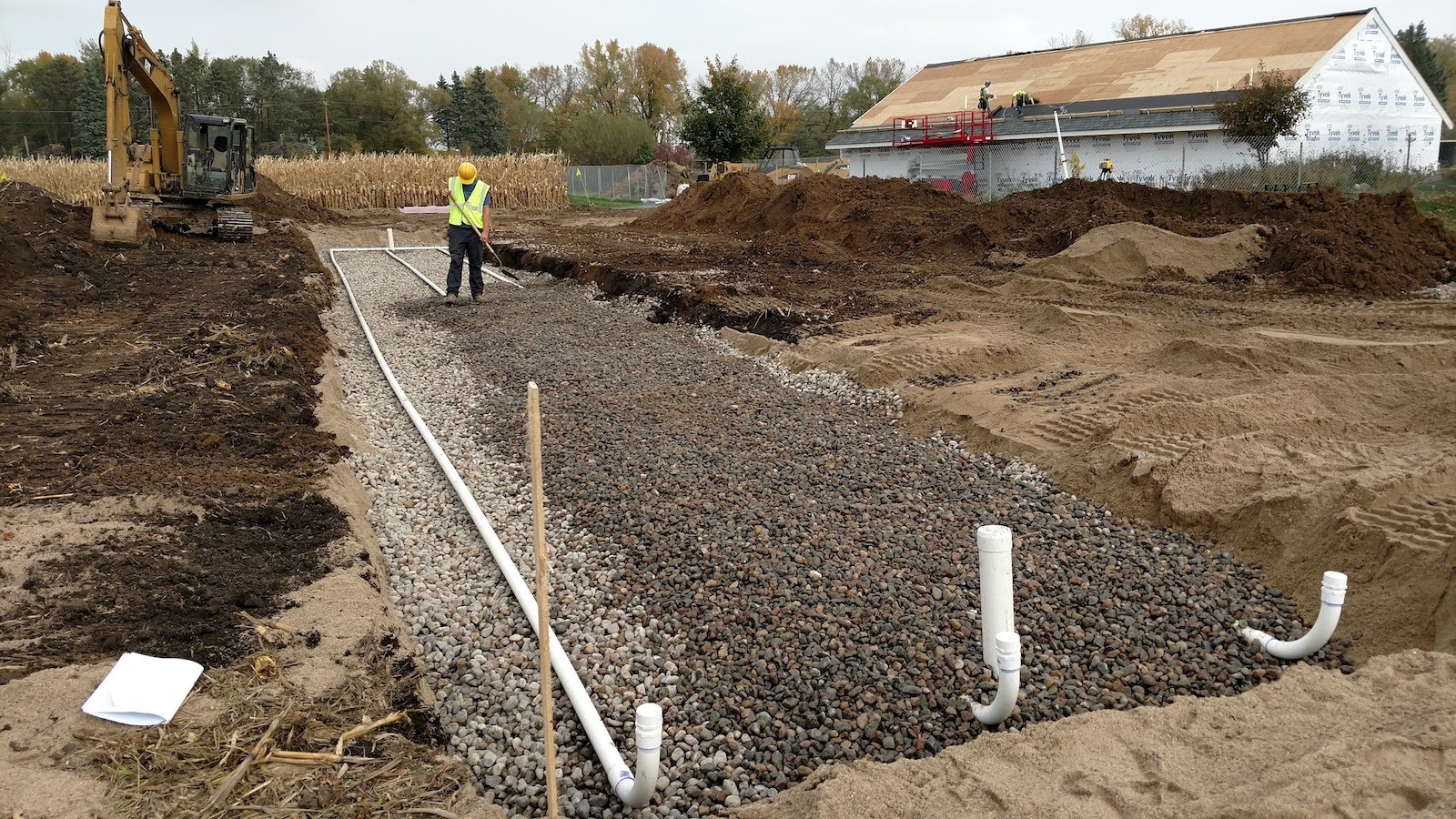
Drawing and Submission Process for Septic Design Milton
The drawing and submission stage in septic design Milton is one of the most important parts of the approval process. Engineers create accurate scaled drawings that show every element of the septic system, including the septic tank, distribution pipes, and leaching bed layout. These drawings must follow the Ontario Building Code and Halton Region’s local requirements. Detailed elevation data, property boundaries, and separation distances from wells or buildings are all included to ensure full compliance. Engineers also prepare a design summary and soil analysis report to accompany the submission. Once all documentation is complete, it is reviewed by the health department for accuracy and safety. Professional preparation minimizes errors, speeds up the approval process, and ensures that every component meets technical and environmental standards before construction begins.
Permitting and Review Process in Milton
Obtaining a permit for septic design Milton involves submitting the completed drawings and technical documentation to the Halton Region Health Department. The reviewing authority checks the design against Ontario Building Code standards and regional environmental regulations. Engineers maintain communication with officials throughout this process to answer any technical questions or provide clarification. This proactive approach reduces delays and ensures all requirements are met before approval. Once the design passes review, a construction permit is issued, allowing installation to proceed. Professional engineers play an essential role in guiding clients through this process, ensuring all documentation is correct and the design meets legal expectations for safe wastewater management.
Installation and Engineering Supervision
Installation transforms septic design Milton from concept to functioning infrastructure. During this phase, engineers work closely with contractors to ensure that every part of the system is installed exactly as shown in the approved drawings. Excavation depth, trench width, and pipe slope must align precisely with design calculations to guarantee effective drainage and treatment. Engineers supervise critical phases such as tank placement, soil compaction, and leaching bed construction. Their oversight ensures that the materials used meet quality standards and that all workmanship complies with provincial codes. Supervision also helps prevent costly mistakes that could lead to early system failure. With professional monitoring, installation remains efficient, compliant, and environmentally responsible.
Inspection and System Approval
After construction is complete, the septic design Milton system undergoes inspection by the health department and the project engineer. Inspectors confirm that the installation matches approved drawings and that materials and workmanship meet Ontario Building Code standards. Engineers conduct independent checks to verify grading, flow direction, and drainage performance. Any discrepancies are corrected before final approval is issued. The system is then certified as operational, meaning it can safely handle daily wastewater flow. This inspection process ensures that both regulatory and environmental standards are met. The result is a properly functioning system that provides long-term reliability and protection for the property owner.
Maintenance and Long-Term System Care
A well-designed septic system can serve a property for decades, but consistent maintenance is critical for its performance. Septic design Milton requires that homeowners follow regular pumping and inspection schedules to prevent solids from clogging the leaching bed. Engineers recommend maintenance intervals based on household size, soil type, and system design. Regular inspection helps detect early warning signs such as slow drainage or surface pooling, preventing costly repairs. Maintaining accurate service records also ensures compliance with health and building regulations. Proper maintenance extends system life, preserves groundwater quality, and maintains the system’s efficiency year-round. Responsible care ensures continued safety and environmental protection for the property and community.
Cost Factors for Septic Design in Milton
The cost of septic design Milton depends on several factors, including soil composition, property size, and system complexity. Clay-heavy or high-water-table sites typically require advanced systems such as raised beds or tertiary treatment units, which increase design and construction expenses. The engineer’s professional services, testing fees, and permit charges also influence the total cost. However, professional design provides long-term savings by preventing system failure and ensuring efficient performance. Investing in a properly engineered design reduces maintenance costs and minimizes environmental risk. Homeowners benefit from transparent budgeting and professional guidance throughout the process, ensuring financial and technical confidence from start to finish.
Common Mistakes Homeowners Should Avoid
Many issues with septic systems arise from design or maintenance mistakes that could easily be prevented. Homeowners sometimes underestimate the importance of professional engineering in septic design Milton, leading to designs that do not meet local requirements. Skipping soil testing or using unqualified contractors often results in poor system performance or contamination risks. Neglecting routine maintenance shortens the lifespan of even the best-designed systems. To avoid these problems, homeowners should rely on licensed engineers for both design and oversight. Professional guidance ensures regulatory compliance and system efficiency. Proper design and care prevent costly repairs, environmental damage, and health hazards associated with septic system failure.
Technological Advancements in Septic Design
Modern technology continues to improve septic design Milton by making systems more efficient and environmentally friendly. Engineers now use advanced modeling tools to predict how wastewater will move through different soil layers, allowing for greater precision in design. Smart monitoring devices are increasingly used to track tank levels, flow rates, and treatment performance in real time. Aerobic treatment systems and tertiary filtration units enhance effluent quality before it reaches the soil. These innovations allow septic systems to perform more effectively while reducing environmental impact. Professional engineers integrate these technologies into designs to create systems that meet the growing demand for sustainability and reliability in Milton’s expanding communities.
Environmental Protection and Sustainability
Environmental sustainability is at the heart of every septic design Milton project. Engineers prioritize protecting groundwater and surface water by ensuring that effluent is treated within the soil before reaching the water table. They calculate loading rates and system placement to maintain safe separation distances from wells and watercourses. Sustainable materials and design methods are used to minimize environmental disruption during installation. In Milton, where population growth and environmental awareness are both high, sustainable septic designs support community goals for clean water and responsible development. Engineering precision ensures every system functions safely while preserving the region’s natural ecosystems.
Professional Oversight and Accountability
Professional accountability ensures the integrity of septic design Milton from start to finish. Licensed engineers are responsible for every aspect of design accuracy, documentation, and compliance. Their certification through Professional Engineers Ontario provides a legal and ethical framework that protects property owners and public health. Engineers verify that construction adheres to the approved design and that all performance standards are met before final sign-off. This accountability guarantees transparency and reliability throughout the project. Clients benefit from working with a professional firm like Elmid Design Inc, which combines technical expertise, ethical responsibility, and regulatory compliance in every project it undertakes.
The Importance of Local Knowledge in Design
Local expertise is invaluable when developing septic design Milton because soil and groundwater conditions vary throughout the region. Engineers familiar with Halton Region’s environmental policies and soil classifications can design systems that fit local conditions precisely. They understand seasonal variations and the specific permit requirements of the Town of Milton. This insight allows for faster approvals and more effective system performance. Professional firms with local experience, such as Elmid Design Inc, apply this knowledge to deliver designs that combine efficiency, compliance, and environmental awareness. Their understanding of regional factors ensures successful outcomes for both homeowners and regulators.
Sustainable Growth Through Engineering Innovation
Sustainable growth in Milton depends on responsible wastewater management supported by professional engineering design. Septic design Milton plays a key role in maintaining public health while supporting development in rural and suburban areas. Engineers design systems that handle population growth without overloading local ecosystems. Their focus on innovation ensures every system meets environmental goals and building code requirements. Sustainable septic systems contribute to cleaner water, stronger communities, and a balanced approach to development. Professional engineering leadership continues to shape Milton’s progress by providing efficient, compliant, and environmentally responsible wastewater solutions for future generations.
Role of Elmid Design Inc in Septic Design Excellence
Elmid Design Inc stands out as a trusted provider of septic design Milton due to its proven expertise, professional accreditation, and commitment to sustainable engineering. The company holds a certificate of authorization from Professional Engineers Ontario, ensuring that every design meets legal and ethical standards. Its team uses advanced engineering methods and local experience to create systems tailored to each property’s unique conditions. From soil testing to final approval, the firm provides complete project management with transparency and precision. Homeowners and developers choose Elmid Design Inc for its reputation, reliability, and dedication to creating high-quality, compliant septic systems throughout Milton and Ontario.
Advanced Engineering Methods in Septic Design Milton
Modern septic design Milton uses advanced engineering methods to achieve efficiency, durability, and environmental protection. Engineers now rely on computer modeling, digital soil mapping, and hydrogeological analysis to evaluate how wastewater will interact with soil layers. These technologies allow precise system layouts that optimize drainage and reduce the risk of contamination. Hydraulic flow simulations help determine the most effective leaching bed configurations, ensuring even effluent distribution. Engineers also integrate energy-efficient pumps and filtration systems to improve treatment quality. By combining data-driven design with professional experience, engineering firms in Milton deliver septic solutions that meet both technical and environmental performance goals, supporting sustainable property development across the region.
Local Site Adaptation in System Design
Each property in Milton presents unique challenges that influence the final septic system design. Some sites feature clay-heavy soils that drain slowly, while others have sandy terrain that absorbs water too quickly. Engineers tailor septic design Milton to address these differences by adjusting system type, elevation, and distribution methods. In areas with high groundwater levels, raised or tertiary systems are implemented to ensure safe filtration and prevent pollution. Customization also considers the property’s slope, vegetation, and available space. This adaptive design process ensures every system functions efficiently within the site’s natural conditions, providing long-lasting wastewater treatment solutions that comply with Ontario’s regulatory framework.
Climate Impact on Septic System Performance
Milton’s variable climate directly affects the design and operation of septic systems. Engineers account for seasonal changes such as heavy rainfall, snowmelt, and freezing temperatures when creating septic design Milton. These environmental factors influence groundwater levels and soil absorption rates, requiring systems to be properly insulated and graded for year-round performance. Designs incorporate frost-protected piping, suitable cover depths, and controlled drainage to prevent seasonal disruptions. Accounting for climate ensures that septic systems continue to perform effectively during both wet and cold conditions. This proactive engineering approach helps homeowners avoid system failures, protect groundwater, and maintain compliance with environmental standards throughout the changing seasons.
Integration of Advanced Treatment Systems
Advanced treatment systems have become a major part of septic design Milton, offering superior purification and environmental safety. These systems use biological, mechanical, and chemical processes to treat wastewater before it enters the soil. Aerobic treatment units and tertiary filtration systems reduce nutrient and pathogen levels, protecting groundwater and nearby water bodies. Engineers determine when advanced treatment is necessary based on soil limitations, proximity to wells, and property restrictions. By using these high-performance systems, homeowners achieve cleaner effluent and longer system life. This integration reflects the shift toward more sustainable and efficient wastewater management in Milton’s expanding residential and rural communities.
Monitoring and Preventive Maintenance
Regular monitoring and preventive maintenance are essential for extending the lifespan of septic design Milton. Engineers recommend routine inspection of tanks, pumps, and leaching beds to identify potential issues before they cause failure. Advanced systems may include digital monitoring tools that provide real-time performance data. Preventive maintenance ensures optimal operation and helps homeowners plan for minor repairs before they become major expenses. Professional inspections also verify that the system continues to meet regulatory requirements. By combining technology with ongoing professional support, engineers help homeowners maintain system efficiency, safeguard water quality, and protect their investment for years to come.
Importance of Licensed Engineers in Septic System Approval
Septic design Milton must always be prepared and approved by a qualified professional. Licensed engineers possess the technical knowledge and legal authority to create systems that meet Ontario Building Code and environmental protection standards. Their involvement ensures that every detail, from soil analysis to hydraulic design, meets regulatory expectations. Engineers take responsibility for the accuracy and compliance of the system, providing stamped drawings and documentation required for permit approval. This professional accountability gives property owners confidence in both the safety and performance of their septic system. Relying on licensed engineers ensures every project adheres to the highest standards of quality and reliability.
Environmental Protection and Groundwater Safety
Protecting groundwater is one of the primary objectives in septic design Milton. Engineers use scientific methods to ensure wastewater is properly filtered through the soil before reaching the water table. By maintaining the correct vertical separation distance between the leaching bed and groundwater, contamination risks are minimized. Systems are also designed to manage effluent loading rates carefully, preventing oversaturation and runoff. Engineers integrate environmentally conscious materials and techniques that reduce pollution and promote soil health. These measures support clean water initiatives and preserve local ecosystems. Properly engineered septic systems contribute significantly to Milton’s long-term environmental sustainability and public safety.
Future Trends in Septic Engineering
Septic design Milton continues to evolve through innovation and technological advancement. The future of septic engineering includes smart monitoring systems, renewable energy integration, and modular treatment components that adapt to changing environmental needs. Engineers are also exploring eco-friendly materials and designs that further minimize carbon footprint. Real-time performance tracking will allow proactive maintenance, reducing system downtime and repair costs. As Milton continues to grow, these modern systems will help balance urban development with environmental responsibility. Ongoing research and development in the field of wastewater engineering will ensure future septic designs are more efficient, sustainable, and resilient to climate challenges.
The Role of Elmid Design Inc in Milton
Elmid Design Inc plays a leading role in septic design Milton, offering professional engineering services that combine innovation, compliance, and environmental stewardship. With certification from Professional Engineers Ontario, the firm provides trusted expertise in system design, permitting, and inspection. Their engineers use advanced modeling tools and local knowledge to create systems suited to Milton’s unique conditions. The company’s reputation for technical precision and ethical practice ensures that every project meets or exceeds regulatory expectations. Elmid Design Inc remains committed to sustainable engineering solutions that protect groundwater, enhance property value, and support responsible development across the Halton Region and Ontario.
Community Growth and Sustainable Development
As Milton continues to grow, septic design plays an increasingly important role in supporting sustainable development. Many rural and semi-rural properties rely on septic systems, making professional design vital for community health and environmental preservation. Engineers design systems that align with the town’s environmental goals, ensuring new developments coexist harmoniously with nature. Sustainable septic design Milton prevents water contamination and preserves land quality for future generations. Through professional engineering oversight, these systems promote balanced growth that respects both regulatory standards and ecological integrity, reflecting the town’s long-term commitment to sustainable infrastructure planning.
Professional Accountability and Transparency
Accountability and transparency define the success of septic design Milton. Licensed engineers maintain responsibility for each stage of the project, from evaluation to final inspection. They ensure full compliance with all applicable codes and environmental standards. Transparent communication between the engineering firm, client, and municipal authorities builds trust and efficiency throughout the project. Firms like Elmid Design Inc uphold professional ethics while maintaining clear documentation and regulatory coordination. This level of accountability ensures that every septic system installed in Milton provides safe, efficient, and sustainable wastewater treatment. Homeowners benefit from confidence in design quality and environmental protection.
Engineering Collaboration and Innovation
Effective septic design Milton depends on collaboration between engineers, contractors, regulators, and property owners. Professional teamwork ensures that systems are designed, built, and maintained according to best practices. Engineers coordinate with local inspectors and construction teams to achieve smooth project execution and long-term performance. Collaborative efforts also encourage innovation by combining practical field experience with scientific knowledge. This cooperative approach supports both technical precision and community well-being. Through collaboration and ongoing research, engineering firms continue to advance septic design technology, contributing to Milton’s goal of sustainable infrastructure and responsible environmental management.
Frequently Asked Questions
Who can design a septic system in Milton?
Only licensed professional engineers or registered designers with Building Code Identification Numbers can design and submit septic system plans in Ontario.
How long does a septic system last in Milton?
A properly designed and maintained septic system in Milton can last more than twenty-five years, depending on soil conditions, water use, and maintenance frequency.
What permits are required for septic design Milton?
All septic systems must be approved under the Ontario Building Code Part 8 and permitted through the Halton Region Health Department before construction begins.
What is the main cause of septic system failure?
Most system failures result from poor design, unqualified installation, or lack of maintenance. Overloading the system and using harmful chemicals can also cause early damage.
Why should I choose Elmid Design Inc for septic design in Milton?
Elmid Design Inc provides licensed engineering services backed by Professional Engineers Ontario certification. Their expert team ensures every septic design in Milton is efficient, compliant, and environmentally sustainable, offering homeowners long-term peace of mind.

Trusted Engineering Professionals in Ontario
Elmid Design Inc is a licensed engineering firm providing expert septic design Milton and specialized civil engineering services across Ontario. Backed by a certificate of authorization from Professional Engineers Ontario, the firm delivers precise, regulation-compliant, and sustainable wastewater solutions. Its experienced engineers use advanced design tools, local expertise, and environmental insight to ensure every project meets technical and legal standards. Known for professionalism, transparency, and reliability, Elmid Design Inc continues to help homeowners and developers achieve safe, efficient, and environmentally responsible septic system designs that stand the test of time.
Geographic Locations That We Service:
Our Licensed Professional Engineers specializing in Engineered Site Grading Plans offer the best-engineered site grading plan, lot grading and erosion plan, and drainage plan to obtain site plan approval and building permits in Ontario, including a wide range of municipalities. Each area boasts unique features and requirements, making our tailored approach essential for success.
Toronto and Surrounding Areas
In the vibrant heart of Ontario, we service Toronto (City of Toronto) and surrounding areas. Additionally, we cover Oshawa (City of Oshawa), Pickering (City of Pickering), and Clarington (Municipality of Clarington). Furthermore, our expertise extends to Ajax (Town of Ajax), Whitby (Town of Whitby), Brock (Township of Brock), Scugog (Township of Scugog and Uxbridge (Township of Uxbridge).
Halton Region
Moving to the Halton Region, our services encompass Burlington (City of Burlington) and Halton Hills (Town of Halton Hills). Also included are Milton (Town of Milton) and Oakville (Town of Oakville).
Peel Region
In the Peel Region, we provide services in Brampton (City of Brampton), Mississauga (City of Mississauga), and Caledon (Town of Caledon).
York Region
Our services in the York Region cover Vaughan (City of Vaughan), Aurora (Town of Aurora), and East Gwillimbury (Town of East Gwillimbury). We also cater to Georgina (Town of Georgina), Markham (City of Markham), Newmarket (Town of Newmarket), Richmond Hill (City of Richmond Hill), Whitchurch-Stouffville (Town of Whitchurch-Stouffville), King (Township of King), and Bradford-West Gwillimbury (Town of Bradford-West Gwillimbury). Each municipality here offers a distinct setting, requiring our specialized approach.
Other Southern Ontario Cities and Towns
We also serve many other cities and towns in Southern Ontario. These include Hamilton (City of Hamilton), St. Catharines (City of St. Catharines), Niagara on the Lake (Town of Niagara on the Lake), Brant (County of Brant), Cambridge (City of Cambridge), Kitchener (City of Kitchener), Waterloo (City of Waterloo), and Woodstock (City of Woodstock). Furthermore, we operate in Guelph (City of Guelph), Centre Wellington (Township of Centre Wellington), Shelburne (Town of Shelburne), Orangeville (Town of Orangeville), New Tecumseth (Town of New Tecumseth), Essa (Town of Essa), Collingwood (Town of Collingwood), Wasaga Beach (Town of Wasaga Beach), Barrie (City of Barrie), Midland (Town of Midland), Orillia (City of Orillia), Ramara (Town of Ramara), Minden Hills (Town of Minden Hills), North Kawartha (Town of North Kawartha), Kawartha Lakes (City of Kawartha Lakes), Peterborough (City of Peterborough), Selwyn (Town of Selwyn), and Brighton (Municipality of Brighton).

